
The Vorthos Guide to Magic: The Gathering

Remember the Weatherlight, Part 4: Downward Spiral
The year was 1999. The last Duelist publication, a Mercadian Masques players’ guide, was released. The Magic community was still reeling from the wanton brokenness of Urza’s block while being hemmed in by the hordes of electric rodent worshippers; players wondered if WotC would be able to save the game. I don’t have a quote and I’m not sure if he even said it, but I’ll bet dollars to donuts if you asked MaRo at what point Magic was closest to dying, Urza-Masques would be his reply. In other words, the exploits of the Weatherlight were a much lower point of interest than they were during the Rath Cycle, a full year previous.
Needless to say, some players had a hard time remembering what was going on at the end of Exodus. This was helped a bit by the anthology Rath and Storm, but only for those who read it. As I said previously, the story for Weatherlight, Tempest, Stronghold, and Exodus was crammed into one novel-sized book, while the stories dealing with Urza took up four—another misleading indicator of the story’s emphasis. Story fans were so used to Urza at this point—and so few people cared about Gerrard—that only the fans of Ertai were on the edge of their seats to find out what happened next. And they wouldn’t find out for a good while longer.
WotC support for the storyline of Masques block was barely any more than what we see today—possibly less, as magicthegathering.com has an occasional Arcana on the setting or story, and WotC had not yet given Magic a strong web presence. Without Duelist, we were limited to the cards themselves (which featured considerably less story moments than they had previously, to the point that you could no longer piece together the whole tale with cards alone) and to the books—though the books, at least, were more easily available in newfangled “Fat Packs,” meaning you didn’t need to make an extra trip to the book store. Even so, the easy access to story info we had during the Rath Cycle was gone—if you wanted to know what was going on, you had you had to go out of your way and read the books—there was no easy way out.
Nor, as it turned out, was there an ‘easy way out’ for Gerrard and the remaining crew of the Weatherlight. After having ditched Ertai and barreled through the portal on Rath, the ship is out of control and performs what I like to call the Gerrard Maneuver.
Times Weatherlight has crashed: 2
To be fair, it isn’t easy to steer a wooden vessel going several hundred miles an hour a few hundred feet above the ground, and probably on fire. The impact was only survivable because of Sisay’s l33t piloting ski11z—though a few nameless crewmembers are still injured. Once the ship comes to a rest, Gerrard—and the readers—assess the situation.
Though understandably pumped-up on adrenaline and concerned with what plane he’s on now, the one thing Gerrard isn’t worrying about is the one thing his character would be—Mirri. The Cat-Warrior had been his best friend, and was killed not half an hour ago for him, yet he gives her barely a thought. For anyone, this would be strange; for such an angsty, brooding character as Gerrard, it is downright confusing. Moreover… where were the Soltari? Part of the deal they had made with Ertai—and Urza—was that they would get to escape Rath through the portal. Did they walk through, into non-existence? They certainly weren’t discussed on any cards, or in the books—and one would think an entire race of people would be more difficult to lose track of than that.
Problem was, most players had forgotten about the Soltari, and the sting of Mirri’s death was long since recovered from. Both WotC and the book’s author, Francis Lebaron, managed to ignore important details, and the fan backlash was minimal—either the main Magic public didn’t notice, or didn’t care. Which isn’t to say some didn’t notice, but the outcry was small enough that WotC may have taken it as an indicator of public interest.
Regardless, Gerrard knows he needs to get Weatherlight fixed, and hears of a powerful marketplace city nearby. While he is talking to a local boy named Atalla a tremendous wave comes and snatches the ship—with only Orim and the wounded still aboard.
Times Weatherlight has been captured: 1
Atalla wants to go with Gerrard and his company to Mercadia City, but Gerrard has other plans—he might not have been able to defend his ship, but like hell he isn’t going to go reclaim it. However, before he can even finish burying his dead, an army of Mercadians come to investigate the crash. Though the Mercadians themselves suck in combat, their mounts are pretty potent, and there’s just an awful lot of them anyway. Gerrard surrenders, (insert French joke of choice here,) and the crew is taken prisoner.
For her part, Orim’s situation isn’t very comfortable either. The localized flood carrying the ship off knocks her and her patients around, though she does what she can to tend to them. When she finally reaches her unintended destination, she has some culture shock—and a language barrier—to overcome. The Cho-Arrim—a white-aligned hippie commune who uses water magic and lives in a forest—treat her and her comrades well, but their healing abilities offend her sensibilities. Those crewmembers
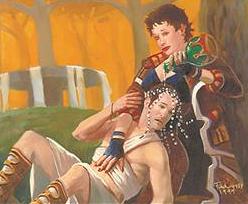
The Cho-Arrim didn’t know about
the vast curative properties of
Head and Shoulders.
While Orim is going native with the Cho-Arrim, Gerrard and the rest of the crew are taken to Mercadia City itself, sitting stupidly atop an upside-down mountain (so, I think we can assume that geology works in funny ways on Mercadia). As prisoners, they are taken from the crappy lower city up a lift to the high market, where they see the opportunity to make their escape. They break loose of their confinement (in an amusing scene involving purple melons and a giant dancing with Karn and a Cateran Mercenary) with the help of Atalla, the Mercadians’ inexplicable obedience to Squee, and the fact that Mercadians are all completely bloody incompetent (more on this later). Gerrard’s reputation, magnified by that stupidity, turns him into something of a legend over only a few days—which he and Takara plan to use to their advantage.
The two venture to Tower of the Magistrate to make a deal with the (nominal) leader of the city. Here, they discover that the Magistrate is, like any other human in the city, a moron, and the true root of Mercadian stupidity—they are
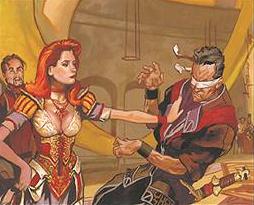
Takara is not only a lot more ruthless
than we expected, but strangely more,
shall we say, endowed than she had
been in earlier depicitons.
After about a month, Gerrard has passed on all his infinite military wisdom to the Mercadians, and created a formidable fighting force. He leads them into the Rushwood against the Cho-Arrim, his forces accompanied by some Cateran mercenaries. They attack the Cho-Arrim mercilessly, easily slaughtering a lot of the rebels before Orim halts his assault—but not before Cho-Manno and her other friends have been killed. She calls Gerrard a blind, selfish moron who didn’t realize that the Mercadians themselves are blind, selfish morons and their enemies might just be the decent people in the equation (which Sisay pointed out earlier, but Gerrard was paying more attention to Takara’s hatemongering).
Quote from
Gerrard: Orim, I don’t understand…
Orim: No, of course not! How could you? You’ve never made an effort to understand anything.
Ah, I like that. That makes me smile. Anyway, Gerrard belatedly calls off his troops, but the Caterans keep attacking. Gerrard turns his troops on them to stop the killing, and starts talking to Orim after the battle—just long enough for the surviving Caterans to start ordering Gerrard’s troops around, taking the Weatherlight for themselves, and arresting Gerrard again.
Times Weatherlight has been captured: 2… and Gerrard hasn’t even recaptured it yet.
The crew is taken again to Mercadia city, Gerrard to be executed—by having a pile of Mercadian trash and excrement dropped onto him from the top of the inverted mountain—while his comrades were to get away with incarceration—but Squee and Atalla come to the rescue, playing the Goblin’s authority against the Mercadian’s stupidity. And if you think I’m exaggerating, have a look at this:
Quote from
The giant scratched a knobby torso. “We was told to bring this load of crap to this here street and dump it when we seen the flare.”
“This-Here Street? This isn’t This-Here Street.” Atalla shook his head. “This street is That-There Street. Dumping’s not allowed on That-There Street.”
The giant shook his head, bedeviled. “This here street isn’t This-Here Street?”
“No,” Atalla affirmed. “This here street is That-There Street.” He pointed to an adjacent road. “That there street is This-Here Street.”
Gaping, the giant said, “I’ll be damned.”
This gambit succeeds not only in saving Gerrard, but transferring his sentence onto his executioners… and these people rule the plane with an iron fist how, exactly? For escaping, the crew becomes even more famous in the city, allowing Orim and Sisay to negotiate a new deal—Gerrard and Tahngarth are to remain captive, while the women go off to Saprazzo to get something called the Matrix to repair the Weatherlight with, then to perform one mission (specifically not against the Cho-Arrim) for the Mercadians to earn back the prisoners’ freedom as well as ownership of Weatherlight itself. This mysterious matrix was the “Mind of the Uniter” for the Cho-Arrim, while Hanna recognizes its description from the Thran Tome as part of the Legacy. (As to how part of the Legacy found its way to Mercadia at all or Saprazzo in particular… who the hell knows?). They travel to Saprazzo via Rishada, and meet with the Saprazzan Vizier, who takes kindly to them and quickly helps free them from Mercadian misinformation. The Mercadians, too, have a Ramos myth, involving a great artificer-king who wished to touch the stars, and bringing his people here to this world. The Vizier is hesitant to grant the Power Matrix to the group—it is the holiest object in their culture—but is willing to think about it. That night, Orim overhears one of the Mercadians that came along plotting to steal the Power Matrix for his
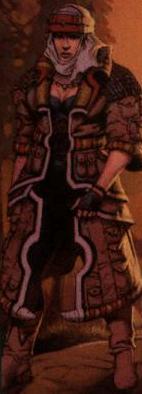
What’s this? A fantasy
heroine that isn’t a
scantily-clad supermodel?
We love you, Orim.
While the other ladies are away, Takara makes sure Gerrard and company are well treated… while getting her claws deeper into Gerrard’s psyche. One drunken night, she further convinces him of the power of hate, and that all his misery comes from his ‘betrayal’ of Vuel… causing a little spat between Tahngarth and Gerrard when the latter’s allies try to convince him of the flaws in Takara’s spiteful ruminations. After Squee—whose ego has been Giant Growthed, comments that he has been ‘turning mean’. The group’s trust in Takara is broken. Karn also produces one interesting tidbit of information—the Mercadians are somehow descendents of the ancient Thran, a race ancient even in the time of the Brothers’ War. Most curious.
Outside Gerrard’s cell, Takara and her blinded father win an audience with the Magistrate, wishing to give Starke “his due,” then beginning to beat him. He protests, hurt and confused, as she makes a tirade against his treachery, as her voice slowly changes, deepens. With horror, Starke recognizes her voice – Volrath! “Takara” had been Volrath all along – if the real Takara was even still alive, she was still rotting away in the Stronghold somewhere. He gloats over Starke’s prostrated form for a bit, then finally gives him what he considers to be his due. With that score settled, he continues his contrived plan to claim the repaired Weatherlight and get revenge against Gerrard. However, as he tries to repair and even improve Weatherlight, he is stymied by the fact he’s using Mercadians to do so – and these guys aren’t exactly bright. They inform him that they are missing five strangely shaped pieces to make the Power Matrix fit into the engine core.
Orim, imprisoned, is nevertheless well-treated by the Saprazzan merfolk, even being interviewed by the vizier. Nevertheless, her loneliness has only deepened with incarceration – until Cho-Manno arrives! Turns out, he was only mostly dead (as any judge would have told her, she should have read his card). After recuperating, he heard from his Ramosian sources – Mercadians who oppose the Kyren – of Orim’s mission to Saprazza, and followed to negotiate with them about uniting the “Children of Ramos.” Orim doesn’t care about that for the moment – simply seeing Cho-Manno again is the happiest moment of her life. (Audience: “Awww.”) After a quick mind meld, Orim is exonerated in the Vizier’s eyes, and they decide to use the Mercadian agent that accused her to their own ends.
The Mercadians, led to believe that the Saprazzans are on their side, are easily outmaneuvered. Orim and the others sail back, quickly busting Gerrard and the others from their cell with little difficulty. Gerrard apologizes to Cho-Manno for his role in the slaughter of the Cho-Arrim, and the rebel leader knows he must accept the pansy’s help. The group immediately decides to split up, one half to find and reclaim the Weatherlight, the other to go get the Bones of Ramos – five mysterious artifacts that will uberize the engines (somehow) when combined with the Power Matrix. Gerrard, Tahngarth, Sisay, “Takara,” and some Weatherlight redshirts go off to the ghoul-infested Deep Wood, where Ramos fell. Orim and Cho-Manno work to get the Ramosians to revolt, while Karn, Hanna, and Squee will try to find out where the Weatherlight has been hidden.
Gerrard and his away team do a little fighting, and make it to the Henge of Ramos to discover the origin of Ramos itself: it seems thousands of years ago, in the wake of Urza’s sylex blast ending the Brothers’ War, a gigantic hole in the plot spawned a dragon engine that yanked some merfolk and a ship full of people from Dominaria, dropped them on Mercadia, and crashed. And, sadly, that’s not really a cop-out explanation – Ramos claims to be a dragon engine Urza himself captured from Phyrexia – when Urza never went to Phyrexia or controlled any such creatures. Even more, Urza allegedly reprogrammed Ramos to protect the wounded and innocent – which is simply out of character for Urza, as he is portrayed post-revision. The only part of this that smacks of Urza is the fact that Ramos destroyed a city when he crashed, killing far more people than he saved. All of Ramos’ explanation is, like the various cultures’ renditions of it, mythological sounding, though we have no more accurate source for its origin, and Gerrard flat out states “It is no myth.” When questioned about the topic, at least one WotC author has simply answered that Ramos was lying, though toward what end, who can say. It’s as sensical an idea as any. Regardless, Gerrard gets Ramos blessing and is given the Bones – five powerstones, in actuality, recharged by the local dryads. “Takara” promptly vanishes with the artifacts, leaving Gerrard and the others behind.
Back in Mercadia, Squee has stumbled upon not just the Weatherlight, but an entire armada of skyships, some even bigger than Predator, in a massive subterranean hangar. Intermingled with Kyren and Mercadian workers, Phyrexians help build the ships and repair the Weatherlight.
Squee-3P0: Phyrexians? Here? We’re in danger. I must tell the others. Oh no, I’ve been shot!
Okay, not quite – but close (and, word to the wise – watching the Star Wars trilogy repeatedly
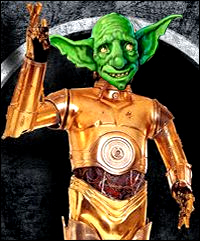
I’m rather embarrassed, but
I do believe that they think
I am some sort of god.
Gerrard, Sisay, Tahngarth, and their remaining Weatherlight grunts smuggle themselves into the city, and manage to stumble upon the subterranean hangar. Rushing down the passage to reclaim their ship, Gerrard sensing where Weatherlight is, and that they need to hurry. Hanna, meanwhile, has had the ship a step away from fixed for some time (including the installation of the Juju Bubble… somehow), and has spend the rest of it stalling and looking busy. Volrath calls her bluff, and he makes ready to sail.
Taking further advantage of Mercadian incompetence, Gerrard leads what’s left of his crew deeper into the hangar. The number of Phyrexians and amount of weaponry in their way is staggering – but also convenient, as the ships are so closely packed that blowing one of them up would start a chain reaction. They are further aided by the fact that the only patrolling guards seem to be Goblins – after all, why would a Phyrexian invasion fleet be guarded by Phyrexians? That wouldn’t make any sense.
As for the actual protagonist, Gerrard manages to get into a duel with Volrath at last. The shapeshifter is pleased with himself, having destroyed or taken all Gerrard cares for, and soon to be taking his life. His fleet is destroyed, but what of it? It was borderline insignificant compared to Phyrexia’s main force (in fact, I’m pretty sure Phyrexia didn’t know about it; Volrath probably wanted some forces of his own). Gerrard, of course, bests him in the fight, cleaving him in two. The Weatherlight, liberated by Tahngarth kills the remaining guards around Gerrard and Sisay, and the crew is reunited – and has some snazzy new Phyrexian ray cannons to try out. The dramatic departure signals to Volrath that it is safe to stop playing dead. Gerrard never even learned one of the simplest rules to campaigning in a fantasy setting – always decapitate your enemies. Volrath makes his way toward his hidden flagship, his hatred for Gerrard redoubled.
Outside, the revolt has torn the city apart. Cho-Manno leads the strongest rebel force into the Magistrate’s tower, though it is Orim who kills the Magistrate himself, efficiently and
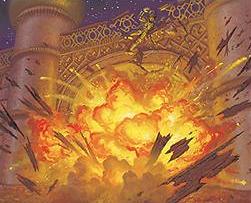
You know, from the way this city is
run, this sort of thing would probably
have happened even without a
violent revolution.
Volrath’s survival goes unknown by the Weatherlight crew, however – the bad guy is dead as far as they know, and Squee can claim the kill. Ramos shows up in perso—, no, in the fle—… no that’s not right either. Well, he shows up anyway and calms down the city, and long story short (if 3,500 words is considered short for a long story), everything becomes happy. Goblins sent to the mountains, the forest gets replanted, Atalla is stupid rich, Ewoks use stormtrooper helmets for drums, it’s all good. Orim has a tearful goodbye with Cho-Manno – they both know she has to remain with Weatherlight, at least until its quest is done. And when she is no longer needed, then she shall return. Weatherlight sails for home, its crew reunited (well, except for all the people who died. And Ertai, who
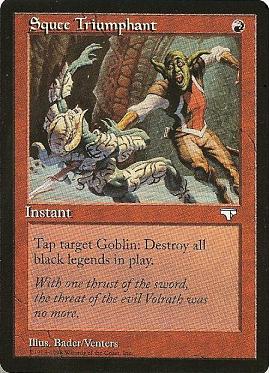
A joke card published in an old Duelist,
little did Squee fans at the time expect it
to be so accurate.
We wouldn’t find out for a while. WotC decided to be cute with this block of sets – instead of the three sets documenting three parts of one arc, they decided instead to recount three separate arcs. This seemed like a good idea at the time, but looking back, this strategy created several problems. For one, the crew of the Weatherlight, especially Gerrard, were supposed to be the protagonists, yet for the year of Urza’s block we had not heard of them at all. During that entire year, the ‘present day’ timeline of Dominaria was on pause as we learned the backstory leading up to this conflict—all the questions of the past were answered. While this narrative maneuver was certainly bold and mostly effective, it had the unexpected side-effect that Gerrard no longer felt like the main character. In hindsight, it seems obvious why—four sets he’s in charge, followed by the three, most recent (and high profile) sets, where he isn’t even born yet. To use a Star Wars analogy, consider if George Lucas actually tried to make three more Star Wars movies now (Yawgmoth preserve us!), after the prequels focused so heavily on Anakin. Moreover, consider if he did this, and, for some reason, the original trilogy was five times as hard to find as the new movies. To say the least, there’d be a debilitating lack of focus. The problem, for The Weatherlight Saga would be exacerbated by the fact that, after a year’s hiatus, Gerrard and crew would only be focused on for a single set… the lack of focus over time made it hard for players who started playing during this period to pick up the story in the middle, or even for those who had been playing all along to keep track. A great illustration of this lack of focus comes from the blurb on the back of the Nemesis novel, which mentions Urza by name, and not the Weatherlight or any of its crew. Where was the focus? Was there any longer any focus at all, or just an inexorable descent into chaos?
Worse, it became difficult for the people telling the story to keep track what was going on – as seen from the numerous plot holes in Mercadian Masques. This was not helped by the fact that WotC itself no longer seemed to care – the best example of this I can cite is Lin Sivvi – or, as her name is spelled in the books, Liin Sivi. (This is not an isolated incident either – Jolrael’s name is misspelled Jolreal in the Pro… Proph… in the “book” she was in.)
(One apparent point of dubious continuity came in the naming structure, or rather lack thereof, but this is actually explained in the book. While many of the vassals and sycophants in the Stronghold maintain the il designation originally described during the Rath Cycle, the names of the heroic characters have abandoned this constraint. While Sivvi is not ever called Sivvi en-Vec, the “Lin” is explained as an honorary title, meaning “striking viper,” after her skill with the toten-vec. Regardless, I shall use the familiar spelling from the cards, because you are likely more familiar with that spelling and it’s actually pronounceable (double i? help?).
All this aside, the story at the time seemed to be going very strong. Nemesis was probably the best of the books since The Brothers’ War and remains a favorite, both for depth of characterizations and for the decidedly dark tone (I have left some details out of my summary, so you should track the book down to get the full story). Though sullied by some questionable continuity (like Masques but to a lesser extent), the quality of the story made it worthwhile. The story picks up moments after Weatherlight blazed its way out of Rath, at the end of Exodus. Eladamri’s daughter is assassinated in her sleep – but not simply to make the elf warlord suffer. Her body is taken to Phyrexia itself, and… modified. The new creation, Belbe, has a specific task – return to the Rathi Stronghold, and oversee the power struggle about to ensue. Volrath has abandoned his post to pursue Gerrard, leaving a
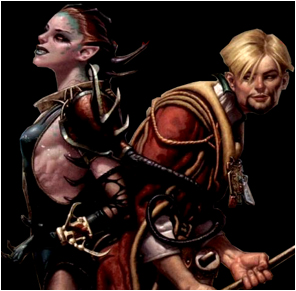
This unlikely pair suffered the worst hosing
of any two characters in the Saga.
The Phyrexians already seem to have a candidate in mind, however – or a faction of them do at any rate. Crovax, cursed, hateful, awakens somewhere in Phyrexia. The Dark Lord, it seems, has had interest in him for some time. They show him his true vampiric nature, show him how to consume the life force directly from the living, and make him an offer – submit to Yawgmoth, and rule. One taste of someone else’s life is all he needs to make his decision. Like Volrath before him, he is heavily modified, but not in the same style; instead of Volrath’s subtle shapeshifting, Crovax is given raw strength and power, and most dangerously of all, is relieved of his mortal conscience. Freed from guilt and duty, he is crafted into a true Phyrexian – an unstoppable, unkillable predator.
He will not be simply given the office of Evincar, however. That is not the Phyrexian way. He shall have to earn it through struggle, by overcoming and conquering other claimants to the throne. His unlikely opponents are not given such Phyrexian support as he is, making his victory seem a foregone conclusion, but the Phyrexians still wish to see him earn his post, and be strengthened by the battle for it.
On Rath itself, the wounded Predator limps back to base, Greven heroically – yet viciously – rallying his crew to keep the skyship in the air. Needless to say, he is not in a good mood when he discovers a stowaway from Weatherlight: Ertai. The fate of the cocky young wizard was something fans of the story had been desperate to know of for a year and a half at this point – he was a popular character who was quite thoroughly screwed over by the rest of the heroes. Magically repelling the Predator crew’s attempts to kill him, Ertai is spared by Greven, who decides at the very least he is worth interrogating – and not wishing to return to Volrath empty handed. Moreover, Greven respected the wizard’s talents at holding back his crew. He privately suggests to Ertai to submit, as he did, to Volrath’s lordship – servitude is better than death. Ertai senses Greven’s spinal implants, and realizes that Greven, in his own way, is as much a prisoner as he.
Predator arrives finally at the Stronghold, but is unable to dock. Greven finally brings Ertai to the bridge to magic them into port – after all, if they crash, he dies too. Greven does what he can to help, but even with Ertai’s considerable ability, it’s something of a controlled crash. Ertai then considers ramming Predator into the Stronghold itself, destroying the ship and devastating the citadel, but decides that his own potential is far too great to waste in a suicide attack. Even so, the ship barely survives the spell Ertai has to use to slow it down, and he is fully spent afterward.
Greven finds the Stronghold in chaos. Though Eladamri’s attack had been repulsed after breaching the outer defenses, Weatherlight had escaped, and Volrath was nowhere to be found. Greven realizes that his despised master had been on Gerrard’s ship, and that, for the moment at least, he was free. The terrified Rathi thralls beg for him to take over, but he declines – he decides instead to notify the dark powers behind Rath, to pick the next Evincar as they always had. Greven does this partly from fear of reprisal, should the Phyrexians not approve of his ascent, but just as much from lack of further ambition – he is a warrior, not a governor (despite how much he may look like Arnold Schwarzenegger). When the Phyrexians say they will be sending an emissary to select the next Evincar, Greven asks if it would not be more efficient to simply appoint someone – and is punished for such insolence. Along with Belbe, the Phyrexians deposit Crovax (or what has become of him) in the Dream Halls, thirsting for blood and with the flowstone that composes the world at his command. But he is not the only one – Ertai, experimenting in spare moments, improvises a modicum of control over the substance.
Crovax reveals himself to the Rathis – and Ertai – first, claiming already to be the Evincar. Greven attacks the newcomer as a pretender, but is unable to kill Crovax before the fighting is interrupted by Belbe’s arrival. Crovax introduces himself as the new Evincar, and is rebuked – while he knew not of Belbe, she has been informed of him. Greven introduces himself and asks for orders, while Ertai, out of turn, introduces himself, and begins to flirt, though he is quickly taken away to be interrogated. Crovax sets immediately to work cowing the courtiers and gaining allies, including another of Greven’s ambitious subordinates (remember Vhati?).
As for Belbe herself… though we never met Eladamri’s daughter in life, there is a distinct sprightliness left in the Phyrexianized elf’s personality. When not in public, she is contemplative, or playful, or lonely. She takes up residence in Volrath’s rooms – finding a telling statue of the Evincar, without a face. When considering who she has met thusfar, only Crovax and Ertai have interested her: the former, because of his obvious Phyrexian favor and dangerous personality; the later, because of his quick wit and overwhelming self confidence. And I mean overwhelming. A few levels down, at that very moment, Greven is trying to torture information from the wizard, but Ertai does everything in his power to resist.
Quote from
“I can keep this up longer than you,” Greven said. He retrieved the fallen iron, now cooled to cherry red, and returned it to the fire. “This can take all day, or it can be over when you wish it to be. What do you say?”
“A modicum of resistance is mandatory,” Ertai said faintly. “After all, I am the most naturally talented sorcerer of the age.”
Greven picked up fresh, hot irons in each hand. “Down here, Boy, you’re just meat.”
Though Greven still views Ertai as a hostage and enemy, he treats him with a sort of professional courtesy or perhaps even respect – indeed, Paul B. Thompson elevates Greven from your standard enforcer-goon to something deeper, perhaps even noble, which certainly keeps things interesting. After all, all the action in the book involves the politics within the “bad guy” camp, so seeing them humanized and some of them even as being likable despite serving the forces of evil explores ground rarely tread in Magic storylines, or other such literature I know of for that matter. Other, subtle examples abound, such as a Rathi chamberlain’s poorly-masked grief at the accidental death of his father.
At the first official meeting after Belbe’s arrival, Crovax and Greven don’t take long to come to blows. Belbe watches calmly, interrupting only to keep them both unarmed. Silently, she cheers on Greven, though the realization of such preference confuses her. Crovax takes a heavy beating, but does not use the flowstone to his advantage – instead, he focuses on, and succeeds in, gaining control of the control rod in Greven’s spine. The Vec commander writhes in pain until Belbe asks Crovax to stop, and for a few moments afterward besides. Crovax presses his claim, but Belbe insists she has much yet to consider and his power remains, as yet, limited. Crovax then asks leave to make an assault on the rebel armies – (he knows the location of the Rebel base!) which is granted. After he leaves, Belbe asks Greven, just now recovering, what he thinks of Crovax’s plan. Greven replies that he thinks Eladamri will kill Crovax – and a large part of Greven’s army with it.
Greven is right to fear Eladamri. His rebellion has gained much support after the late raid, and news of Volrath’s disappearance and the extensive damage to Predator embolden leaders of human and other tribes to join with him – and speed up their timeframe. Eladamri knows that these advantages are temporary, and their best chance for victory is to attack the Stronghold now. Crovax, meanwhile, has a difficult time endearing himself to the troops. His heavy-handed manner overawes them into submission, but excitement or loyalty… not so much.
Belbe admits that Crovax is the leading contender for the governorship, but desperately desires another option. Greven is no longer viable, as he cannot go against Crovax while the vampire controls his spine. Therefore, she goes to visit the only other person she can think of in the Stronghold who might stand up to Crovax -- Ertai. She observes him for a time first, noticing his meager ability to control the flowstone. Then, helping the beaten wizard drink, she offers him an unbelievable deal – if he promises not to attempt to escape, she shall release him, and help him develop his control over the material that makes up the world. If everything works out, Ertai, not Crovax, could become the next Evincar. Ertai laughs at this idea, though the disappointment on her face cuts that short. Nevertheless, when she offers to have him healed and treated better, he decides at least to play along for a time.
Ertai is taken to a Phyrexian Rejuvenation Chamber to be healed, though he hesitates for a moment on the ‘negative energy’ the device operates with (especially after Belbe helpfully mentions that it can cause mutations at higher settings). The device heals him, but alters him somehow – his magic works a little differently, and he isn’t sure how or to what extent.
Eladamri’s and Crovax’s forces encounter each other on their respective ways to battle, but the result is unexpected – Eladamri had taken a Rathi garrison shortly before Crovax arrived, and his troops pretended to be those stationed there. The ruse works to the extent that Eladamri learns of Crovax’s plan – on a plane like Rath, heroes need all the luck they can get, and this is a massive stroke of it. Eladamri presses on once Crovax has left, confident his elves can defeat his unsubtle mass of troops. However, his hand is forced by the impetuousness of a young underling, and he has to fight before a trap could be fully sprung. Even so, a full half of Crovax’s force is killed or wounded, and all its supplies are lost. Eladamri withdraws to regroup, and meet with the Oracle en-Vec.
Greven finds out about Eladamri’s activities – from the same source Eladamri had found out about the goings-on in the Stronghold. Though he would relish seeing Crovax defeated, he goes to Belbe to report the news. He is understandably amazed to discover Ertai is in the running for Evincar, but does not further question it. Belbe asks if he would like to be considered, but he declines again, being “content to remain a loyal servant of the throne,” even though he would be freed of the control rod.
Quote from“I served Volrath for many years, and I’ve seen firsthand the effect unfettered power had on him. I would rather be the blade than the hand that wields it. […]the victim curses the killer, not the blade that cuts him.”
Greven reveals himself to be a man beaten so thoroughly by life that he wishes simply to be a tool – the best tool he can be, but nothing more. He hurriedly changes the subject, reporting that Crovax is very likely walking into a trap. Belbe tells him to do nothing – the expedition is a test of Crovax’s ability, and if he can escape the trap capably, he will have proved himself. Greven points out that, should Crovax fail, an insurrection could result. Ertai suggests taking hostages from the resident Kor, Vec, and Dal populations. The plan is adopted, and Ertai goes up in both Belbe’s and Greven’s estimations. Greven leaves, and Ertai tells Belbe to make sure the hostages are not harmed. If he is to be Evincar, he wants to do it in a very un-Phyrexian way—through support and acclaim of the governed. If Crovax wins, he wants to present the hostages with their freedom. If he loses, he wants to save them from Greven’s vengeance. Besides, he reasons, if they are killed, it would only serve to incite a revolt. The boy wizard is starting to take his contention seriously… or so it seems. Really, he neither thinks he has an honest chance at the position, or even wants it – but playing along may keep him alive long enough for him to find an opportunity to escape to the portal. Somehow.
His tune begins to change as he and Belbe grow closer. Belbe has only been ‘alive’ for a few days, and does not understand her growing affection toward Ertai, and, well… I’d give good odds that Ertai didn’t get much action back on Tolaria. But still, this burgeoning romance is even more convincing and effective than Orim and Cho-Manno, particularly because of the setting. For example,
Quote fromFor reasons she did not entirely understand, Belbe leaned forward and pressed her lips to Ertai’s. He was so startled by this unexpected action he failed to respond in kind. Belbe drew back, expressionless.
“Did I do it incorrectly?”
“I don’t know,” he said. “I wasn’t prepared—”
“Prepare yourself, then,” she said.” “It may happen again.”
That sort of bantery dialogue is all well and good in a vacuum, but consider now that they had just fallen several hundred feet and nearly been killed, on their way to inspect Greven’s hostage-taking operation down in the City of Traitors. These are not just two sympathetic characters falling in love, these are two sympathetic characters falling in love while the world around them falls apart. Even the most optimistic reader wasn’t so hopeful as to expect things to work out happily.
The first sign of trouble arrives soon. The rejuvenation chamber Ertai used doesn’t really heal him, so much as mask the damage – after a time, the extensive injuries return. He has visited the device again and again, and it is altering him – making him physically stronger, and larger, like a mini-Greven. Perhaps more distressing is that he doesn’t mind – power is power, he says; it is only how the power is used that matters.
Further trouble comes with Crovax’s early return – he, too, is growing stronger under Phyrexian influence, and has learned how to teleport. Abandoning his defeated army like Napoleon in Egypt (What? I know more than Star Wars, ya know), Crovax returns home to further his political goals. Belbe is very much unhappy to see him return – every other paragraph she imagines herself maiming the mad vampire. She lets slip during the conversation Ertai’s plan about the hostages.
The army, meanwhile, marches back without him, and is greatly spooked by the completely empty garrison they had visited just a few days previously. Greven arrives heroically in the rebuilt Predator, and escorts his army back to base, leading them in a few small actions to rebuild their shattered morale. But while he is away, the hostages are guarded only by underlings, and soon go missing. Ertai and Belbe quickly work to track them down, along with a leading courtier, but the sheer size of the Stronghold protracts the process. By the time they find Crovax, it is too late – he has Massacred them all, Vlad the Impaler style, if Vlad had been able to summon spears from the ground itself. The courtier weeps and later goes mad – though Rathi, he and the other il are not all bad people. Ertai is nauseated, while Belbe seethes. Sitting in the midst of the gory grove of impaled hostages, Crovax is in immaculate white, holding court over robed and wigged Moggs. Crovax calmly insists that this “little exercise” will allow him to rule effectively, though fear. Belbe again maintains that she cannot name him Evincar yet – he has thus far lost a battle and demonstrated ineffective leadership abilities. Instead of tactics, he knows only blind aggression. Instead of statecraft, he knows only terror. Crovax, still confident in his inevitable selection, simply waits.
Waiting is the last thing Eladamri and the other leaders of the rebellion – including the fierce young Vec, Lin Sivvi – want to do. Quickly gathering more forces in the wake of another victory, they prepare for a further assault. While marshalling these troops, Eladamri meets finally with the Oracle.
Regardless… the Oracle has bad news for Eladamri. He shall never succeed in defeating his enemies on Rath, and his destiny shall take him to the Stronghold in chains. There, the “Dead One” will open a door for him, to a “land of light and color,” where he will be the Korvecdal. The Oracle vanishes after this proclamation, and Eladamri is hailed as the prophesized Uniter. When he hears the news that Predator is again airborne, he decides to eliminate the Rathi air supremacy by infiltrating the Stronghold – in

The great Rathi plot
instigator… or perhaps
someone else in disguise?
The Oracle is a mysterious figure. Before, she named Gerrard as Korvecdal, and now Eladamri. She appears and disappears seemingly at will, and never speaks the plain truth. But she knows much, and her words always instigate others into action. This has led some to theorize that she is, in fact, Urza in disguise – we know he has been interfering with Rath in at least some small way. This theory is intriguing, and not directly discounted by anything I’ve read, though how Urza would be as certain of his prophecies as the Oracle is is difficult to say. However, it could be believably done, and would help explain why Urza is so distracted during Pro…, that is, in the next “book.”
Belbe fears Crovax, and hates him. She knows he is the strongest candidate – indeed, the only real candidate. Yet, she wants to hurt him, to destroy him. She knows that, if named, Crovax would slowly but inexorably destroy every living thing on Rath, and anywhere else he could touch. And the more he kills, the stronger he becomes – she realized after the massacre that whenever he is around death, he grows more powerful. Ertai repeatedly asks her why she does not simply kill Crovax – because she must put the best possible candidate on the Rathi throne. It is her purpose. It is why she was created, why she existed. Ertai tells her to exist for something else, for herself. Belbe calls this weak – the needs of the whole race must be put over the individual. Ertai replies, they are of the same race – she has no common cause with her overlords. That ends the conversation, but before things get intimate, Belbe withdraws – she has a lens within her, a device that sends everything she sees and does back to her masters. Ertai cannot damage it or even understand it, but he thinks he can at least turn it off. They then spend several hours on Volrath’s bed without the company of their clothing, until Ertai falls asleep from exhaustion.
Crovax shows up afterward – perhaps even during, though if so he remained silent. He mocks Ertai, trying to goad him into a fight, pointing out that Ertai may have be shown unexpected favor. Belbe insists that she shall consider leadership abilities only, and not “biological prowess,” but cedes a date for naming the next Evincar. In two days, at midday, the fate of Rath will be decided. Crovax leaves, satisfied, and Ertai quickly follows suit – as he says, the final exam is in two days. Crovax orders his cronies to be prepared – in two days time, he will become Evincar, one way or another.
Ertai has had a profound effect on Belbe. Why can’t she live for her own sake? Crovax killing those innocent people to sate his own thirst for blood – how was that different from the Dark Lord’s plans for Dominaria? She realizes, suddenly, that it isn’t, and decides to do something about it. She tampers with the flowstone generator, decreasing its output to 50% -- if she modifies things properly, the planar overlay will not occur at all. Her masters would fight back, but some simple modifications in the makeup of Rath – with Ertai’s help – could make it as uninhabitable for them as Phyrexia is for normal humans. The rebels could be negotiated with, and Rath governed by law instead of dread. If only… if only Crovax weren’t around.
As for himself, Ertai knows he has no chance against Crovax. That he can manipulate flowstone at all is admirable, but his ability has plateaud – the best he can hope for now is to survive, maybe even escape. But to where? – he considers Dominaria rightly hosed in the coming war. All he really wants now is to escape, and live out the rest of his so-very-promising life. With Belbe.
Eladamri’s plan works swimmingly – the Stronghold is abuzz with news of the rebel leader’s capture. He is brought to the throne room by Greven, where Belbe and Crovax wait. One look at Belbe sets Eladamri into a perfect rage – to have his daughter, first murdered, then turned into this Phyrexian abomination! His assault on Belbe is so unexpected none of the soldiers respond, while Greven and Crovax watch to see what develops – Eladamri’s allies are actually the first to intercede. He is led away to be interrogated – but Belbe insists that he not be killed, and further, that her decision be put off until the following morning so she can take the news of his capture into consideration. Crovax threatens her at first, then accepts this when she points out he cannot become Evincar without her word. At least, he accepts it outwardly – but manages to capture Ertai with the help of some cronies.
Belbe is tired of Crovax’s arrogance, his bullying. If she can convince Greven to support her, she’s ready to name Ertai, and use a special set of Phyrexian weapons to back up her decision. Before she can, Crovax attempts a coup with the threat of ending Ertai’s life. After a brief but violent fight, Belbe submits – she will name Crovax Evincar, but not until tomorrow, when a broken Eladamri will be available to show their overlords as well. Crovax accepts this, taking Ertai along as collateral. Belbe can offer no further resistance – it seems Crovax has won. Nevertheless, she goes to Greven, who Crovax has been systematically tormenting through his control rod at every chance. Greven refuses to help – Crovax is too powerful, and his loyalties, he says with regret, are otherwise committed.
Quote from“I’m not free to act, Excellency[…] I never have been. Though I command armies and the flag on Predator’s bridge is mine, I do not have command of myself. I’m sorry.”
Time is growing short, and Belbe is fast running out of options. But Sivvi and the others continue their mission, oblivious to the political situation. Her party manages to board the Predator, but despite surprise and utter daring, are unable to finagle a way to seriously damage the ship. The alarm sounds, and they flee into the fortress. Below, Greven has tortured Eladamri mercilessly, to no avail – the elf has not even cried out. Greven at length gives up the interrogation, respecting Eladamri’s perseverance, and wishing for his enemy an honorable death. Alarms call him away from the interrogation, and he leaves Eladamri tied up in his cell. The battered elf manages to cut his bonds, splint his wounds, and escape. In an attempt to cause
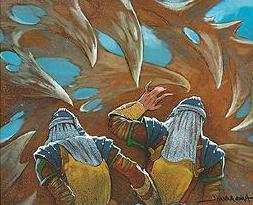
Sivvi’s troops find, as Gerrard did
in Stronghold, that the Phyrexian
citadel is not tourist friendly.
Meanwhile, Crovax’s coronation finally comes, after a desperate but futile series of delays. But before Belbe can name Crovax, Greven steps forward with another man, who calls Crovax an usurper. Crovax tries to flowstone him away, but the newcomer can control the material as well – in fact, better. The man, whom Greven helped smuggle back into the fortress, is none other than Volrath, the absent Evincar himself, returned from his jaunt to Mercadia to reclaim what is his. Even Greven prefers this old tyrant to the new.
Belbe takes this last chance given her – she announces that Crovax and Volrath shall have a death match, the victor of which will be indisputably named Evincar. The two fight mercilessly – as is to be expected – with Volrath having the initial upper hand in skill and experience. However, Crovax proves a much more difficult opponent than Volrath expected, teleporting out of a death stroke to slice open the shapeshifter’s back. Volrath fights back with a wounding attack of his own that sends Crovax sprawling into the crowd – where he starts killing random courtiers indiscriminately to replenish his strength. Ertai arrives, substantially hurt by Crovax but still breathing, and assesses the situation. Volrath has skill, to be sure, and though evil would be less deadly than Crovax, yet the simple fact is that Crovax can replenish his strength indefinitely with the lives of those around him. Volrath cannot win. Seeing this, Ertai decides to try to curry favor with the inevitable winner. At a critical moment in the fight, Ertai turns Volrath’s attack and allows Crovax to defeat the fallen Evincar. Before Volrath can be killed, word comes that the rebels have barricaded themselves in the Dream Halls. Belbe finally does her duty – she names Crovax Evincar of Rath. Volrath is taken prisoner, and Evincar Crovax leaves to deal with the infiltrators, with Belbe in tow.
Belbe manages to convince Crovax to allow her to negotiate with the rebels in person, as the Dream Halls are virtually impregnable and driving them out would be difficult, and there is no other way out. Or so Crovax thinks – Belbe has hidden her portal there, and offers to let the rebels escape, though there it can only handle a few of them. Eladamri realizes now what the Oracle meant in her prophecy – he asks to be sent to Dominaria, to help them prepare for the invasion to come.
Ertai, after healing himself again, arrives, frantic to get into the Dream Halls and use the portal within. He tells Greven about the portal, hoping to stop her from using it for the rebels and not for their own escape. The attack on the doors resumes while Belbe programs the portal within. As soon as Dominaria appears, Takara runs through of her own accord. Eladamri pushes Sivvi through, then turns to Belbe, and without warning, throws the contents of a vial at her – the remainder of the poison found at his daughter’s bedside. Belbe’s death comes quickly, and Eladamri passes through the portal right before the Rathi’s arrive. The device had a maximum weight limit, precluding any further pursuit of the rebels.
They, at least, escape Crovax’s wrath.
Perhaps Belbe’s death is a merciful escape as well – she does not have to see how Crovax rules. Greven is severely punished for his aid to Volrath, and spared only because of his part in the coming war. Ertai’s heart is shattered, leaving him only with the most basic, empty will to live – the same thing that has maintained Greven il-Vec for so many years. For his unsolicited help in defeating the former Evincar, Crovax grants Ertai a life of servitude, a life like Greven’s, but a life at least. Ertai agrees, and, like Greven, is reshaped to fit his new role.
Crovax stages an elaborate funeral for Belbe, requiring attendance of every major noble in the Stronghold. Besides the honorary burning of Belbe’s body, there is a further display – in fact, the true reason everyone is compelled to attend. Volrath – Vuel, now, without all his Phyrexian implants – is brought before the assemblage, defeated but, somehow, unbroken. Anyone showing respect to the defeated is noted and killed later. Ertai, loyal lapdog of Rath, gets the honor of executing the traitor, Vuel. Gerrard’s former blood-brother is injected with flowstone, and Ertai gives it a simple command: disassemble. Bit by bit, the human body of the former Evincar simply falls apart.
Quote from
Vuel landed face upward. As his ears and nose slid from his face, as his teeth bubbled out of his mouth on the last breath from his lungs, he saw the ever-gray sky of Rath change to perfect, cloudless blue. It was the sky of Dominaria, and Vuel, son of Kondo, had returned home at last.
Vuel is disassembled to the last molecule, and all that is left of Belbe is her fire-warped Phyrexian endoskeleton. Ertai wades into the ashes, retrieving her still-warm skull, then scurries away under the stars of his homeworld after finding the Phyrexian lens that, too, survived the flames.
So ends the bleakest chapter of Magic story history – even The Dark was not so depressing as this. This is one of the few books I’ve read in the Magic novel line I actually consider to have literary value – the inevitable, systematic destruction of hope portrayed in this book is just the sort of thing lit professors enjoy. Everyone we loved was destroyed, everyone we hated won, and the world was coming to an end. The stakes for the coming invasion were set supremely high, and Nemesis showed that the good guys didn’t necessarily have to win.
But that’s when things started to go wrong – and I don’t mean within the story. As I mentioned earlier, WotC decided to be ‘cute’ with this block and follow three different, simultaneous plot arcs – the problem being, they didn’t HAVE a third plot arc. The location was easy enough to decide – what is going on on Dominaria itself? The answer, it turns out, is a 300-page “Nothing much.”
Let me say this quickly and bluntly, because this topic hurts my soul – if Nemesis is The Weatherlight Saga’s Empire Strikes Back, then Prophecy is the Holiday Special. It is Highlander II, and Star Trek V, and Galactica 1980. In other words, it is that one entry into the series that is so permeated with such unbelievable awfulness, that is so titanically ill-executed and so poorly thought out that all who encounter it question any religious faith they may have, that is in all totality so monumentally AWFUL, that it makes those foolish or unfortunate enough to be writing about it compose sentences so long and convoluted to insult it that they forget what they were saying. Nevertheless, it is canon, so I must summarize the plot. Here goes:
Keldons invade Jamuraa. Urza too busy to help. Barrin and Rayne go help Teferi defend. Nothing happen long time. Rayne get killed by strange demon thing. Barrin angry and sad. Teferi remember he is planeswalker, kill all Keldons. Teferi bitter.
That’s it. Seriously. The entire plot of the book fits in less than 50 words. And that handful of words does not encapsulate the sheer horror and stupidity that is encompassed in this book – such as Teferi’s unhealthy obsession with zeppelins. Why is the war happening? The Keldons

Yes, it IS that bad.
For readers and players both, there was much sorrow and gnashing of teeth. I have never read a book so awful, and though I’ve played the game since Ice Age, this is the only set of which I have never purchased any product (Not entirely true – I once bought one pack to use in a 16 player chaos draft, where any packs were usable. I laughed and laughed).
Prophecy killed my inner child. It reached deep inside me and destroyed all that was good, leaving only an empty husk who writes stories meant only to torture and torment its readers.
But I’m not going to leave you with such crap as that – I’m not so mean as that, previous statement aside. Very quickly, let me summarize (read: shorten and likely oversimplify) The Thran, the prequel to all of these Phyrexian shenanigans that doesn’t correspond to any printed set (the book itself came out in late 1999, between Masques and Nemesis, so let’s consider it part of the trilogy, despite lack of any real connection whatsoever). I’ll do this very quickly, because this article is already ridiculously long.
The Thran were a mighty empire of artificers on ancient Terisiare. Peace ruled within the empire itself and with its allies – at least, until the return of Darth Side—I mean, Yawgmoth, a renowned healer, from exile, where he had been sent because of his revolutionary theories (and questionable methods).
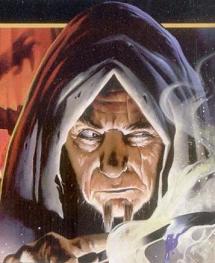
Really, who COULDN’T trust
this face?
Things got a little interesting when a planeswalker named Dyfed – originally Thran herself – arrived. She said that she detected a planeswalker among the Thran elite, though she wasn’t too sure who it was. Glacian and Yawgmoth both were fascinated by the power of this woman – moreso, after she took them “walking,”
ending the tour in the center of a nine-sphered artificial plane whose creator had recently perished. Glacian had previously designed seemingly mad portals for travel to other worlds; after this revelation, Yawgmoth hastened to implement them. He wanted an empty world for the Thran to colonize – they were running out of room, after all, and had something of an impoverished underclass whom Yawgmoth drew support from (particularly from one man, named Gix). After quelling an uprising and making serious progress against the disease, Yawgmoth was hailed as a hero. His power grew, at the expense of the ruling council, who he went so far as to detain – for their own protection.
Meanwhile, he had been developing interest in another Thran woman of note – Rebecc, of course. This was helped by the fact that Glacian had come down with a particularly nasty version of the powerstone disease. Yawgmoth treated the artificer, but without intent to cure – in fact, he actually implanted a large powerstone in the man to hasten his demise. Rebbec gradually began to fall for Yawgmoth’s wiles, spurred on by her husband’s worsening condition. The colonies on Phyrexia had blossomed, and his experiments on curing the disease evolved into experiments on improving life in general – and I don’t mean lifestyles. Yawgmoth sought to perfect living creatures, and mechanical ones at that, bringing the two into synthesis, making the already godlike Thran truly immortal. His power in Corusc—HALCYON, I mean Halcyon!—grew further, and Rebbec began to realize his evil. She asked Dyfed to free the political prisoners, and the planeswalker agreed, depositing them, with some goblin attendants, atop a secure, inverted mountain on a nearby plane for temporary safekeeping.
At least, it was supposed to be temporary. Little did she know that Yawgmoth could no longer help himself from studying Dyfed’s abilities– whether she wanted him to or not. Though planeswalkers are able to regenerate themselves almost immediately, Yawgmoth correctly reasoned that would be difficult if their brains were scrambled, and so he knifed her in the back of the head and set up a machine keep her brain pureed. But he was woefully disappointed – even after a thorough vivisection, he could find nothing in her body out of the ordinary, certainly not the “planeswalking organ” he was looking for.
Yawgmoth’s years of exile finally came back to haunt him – he had spent a lot of time ‘experimenting’ all over the world during his travels. His Thran (Phyrexian, now) armies were not yet strong enough to defeat the combined forces of his enemies – at least, until he captured Glacian’s greatest invention, the Null Sphere, a giant sky-station that could override and control any artifacts, drawing its power from the ambient magical energy of Dominaria. He used it to destroy the invading army, both to hijack their mechanical forces then in a direct assault from the white mana stored in the Null Sphere. That done, he fled to his airship fleet, allowing the Sphere to rise into orbit, becoming a new moon for Dominaria. (The Null Moon, or Glimmer Moon, has been a feature of the Dominarian setting since the very beginning – a strange, mysterious satellite, seen sometimes to sparkle or glimmer of its own accord, and long said to be unnatural.)
This was part of a further plan. He lured his remaining enemies in nearer to Halcyon, and set off stone-chargers – effectively, white-mana nukes – all over the Old Rep… all over the Thran Empire, anywhere that even hinted at disloyalty to his regime. The Null Sphere would, he thought, siphon off the resultant energy cloud before it destroyed Halcyon itself. He miscalculated in this, but had time to appeal to the city’s population – stay and die, or come to Phyrexia and worship him as a god. All but one chose the latter.
That was, of course, Rebbec. The woman had fully realized her folly, but not soon enough to save herself – or
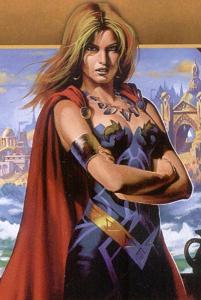
Behind every good villain stands
a woman that scorned him.
Boy, that crazy Yawgmoth! Seriously, it takes some hard-core evilness for a mortal to take down a planeswalker unaided. And though he was sealed away from Dominaria, he had millennia on a world with effectively infinite resources to prepare for his return. He bonded himself with the plane, overseeing its development and truly becoming its god, patiently building, waiting… and all the while, seething with hatred toward his onetime love Rebbec, toward the world that cast him out. He crafted Phyrexia from idyllic paradise into the dread plane of the multiverse, and waited… until the day, thousands of years later, when two young apprentices broke the stone that held his forces at bay, unleashing Yawgmoth again on the world – as well as reawakening Glacian to help fight that old foe.
We knew the backstory. Now, we knew its backstory. It was the fall of the last year of the twentieth century. The story arc that had begun four years earlier was about to enter its final, cataclysmic chapter. So what if the last set – and its story – sucked on such a scale you’d need an astrophysics degree to measure it? That was mere distraction from the payoff to come – the climax in WotC’s grand storyline experiment, the culmination of over 8000 years of Magic continuity to date. Whoever the protagonist actually was, he was about to meet his fate.
The question wasn’t, “Can they stop the war?”
The question was, “Will there be anyone left to rebuild?”
Over the course of the next year, we were about to find out.
Shannon Rezendes is an aspiring author who is not above shameless self promotion: you can view her blog here.
Original Article Edited by Goblinboy
Remember the Weatherlight Banner by iloveatogs
That’s it for this week, thanks for reading! We hope this article whet your appetite for the Weatherlight Saga! If you'd like to read more, Part 5a will be available soon.
Did we miss anything? Let us know in the comments or on the forum, and we’ll address it in future updates. Have a suggestion for something you’d like to see? Let us know, and we could address it in a future column. As always, you can check out our Wiki to learn more.
-
View User Profile
-
Send Message
Posted Dec 16, 2017I just found this interesting essay recently while researching some matters related to the publication of my 2000 novel, NEMESIS. Later, when I update my own blog about my MtG novel, I'd like to quote from this page, if that's okay.
Paul B. Thompson
http://sundipper.blogspot.com/
-
View User Profile
-
Send Message
Posted Aug 12, 2016Thank you for the work accomplished!